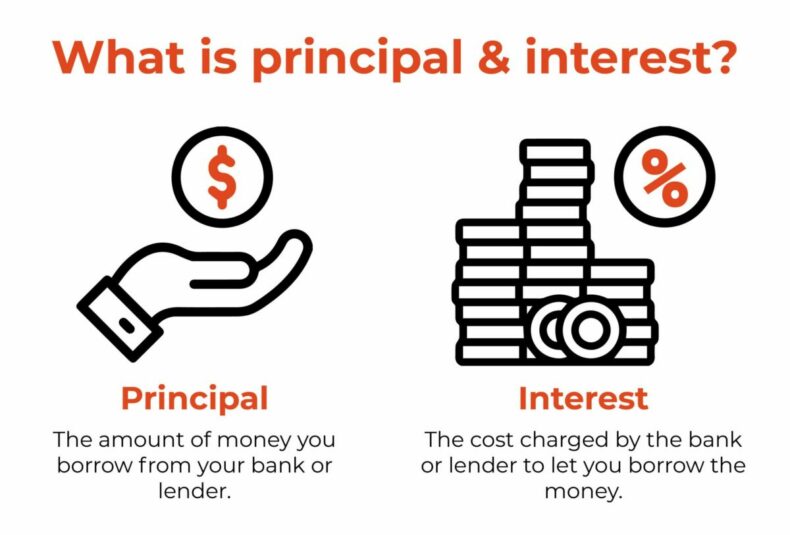Choosing the right home loan can be a daunting task. Then you have to decide between a principal and interest-loan or an interest-only loan. While both loan types have their pros and cons, understanding what choice is right for you can set you on the path toward financial independence.

What is an interest-only home loan?
Interest-only home loans, as the name suggests, only require you to pay the interest on the loan amount for a specific period, usually between one and five years.
During this time, the loan balance remains unchanged. After the interest-only period ends, you must start paying both the interest and a portion of the principal, until the loan is fully repaid.
What is a principal and interest home loan?
Principal and interest home loans require you to pay both the interest and a portion of the principal each period. The principal is the amount you borrow, and the interest is the cost of borrowing that money.
Over time, your payments will go towards paying down the loan balance, reducing the amount of interest you pay and ultimately leading to loan repayment.
Interest-only home loan: Pros and Cons
| PROS | CONS |
| Lower monthly repayments in the short term: Interest-only loans have lower monthly repayments as the borrower only pays the interest on the loan and not the principal. This can be beneficial for borrowers who want to save money in the short term. | Higher interest payments over the life of the loan: While monthly repayments are lower, the interest payments over the life of the loan will be higher as the loan balance is not reduced. This can result in a higher overall cost of the loan. |
| Provides financial flexibility: By paying only the interest on the loan, borrowers have more flexibility to use their income for other purposes such as investments or paying off other debts. | No reduction in loan balance: As the borrower is only paying the interest on the loan, there is no reduction in the loan balance. This means that the borrower will still owe the full amount at the end of the interest-only period. |
| Suitable for short-term investment goals: Borrowers who have short-term investment goals and want to maximize their returns may choose an interest-only loan as it provides them with the opportunity to invest their income elsewhere. | Risk of negative equity if the property value decreases: If the property value decreases, the borrower may end up owing more than the property is worth, resulting in negative equity. |
Principal and interest home loan: Pros and Cons
| Pros | Cons |
| Faster loan repayment and building of equity: Principal and interest loans have higher monthly repayments, which means that the loan will be paid off faster and the borrower will build equity in their property more quickly. | Higher monthly repayments in the short term: Principal and interest loans have higher monthly repayments as the borrower is paying both the interest and the principal. This can be a burden for borrowers who have limited income. |
| Lower interest payments over the life of the loan: By paying both the interest and the principal, the interest payments over the life of the loan will be lower. This can result in a lower overall cost of the loan. | May not be suitable for short-term financial goals: Principal and interest loans may not be suitable for borrowers who have short-term financial goals as the monthly repayments are higher and the loan balance is reduced more quickly. |
| Provides stability and predictability with consistent repayments: With principal and interest loans, the monthly repayments are consistent with the ability to lock in interest rates or leave as variable interest rates, providing stability and predictability for the borrower. | Changes in repayments at end of introductory offers: At the end of fixed interest rate offers, variable interest rates coupled with principal payments can cause a big increase in repayments. |
What is the right option for you?
When to use an Interest-Only home loan
Interest-only loans are best suited for investors who are looking to purchase an investment property and maximise their cash flow in the short term. By paying only the interest on the loan, investors can reduce their monthly payments and redirect the extra cash flow towards other investments or paying down other debts.
Interest-only loans are also suitable for borrowers who are confident that their income will increase over time or have a clear exit strategy to pay off the principal balance. For example, if a borrower intends to renovate and sell the property within a few years, an interest-only loan can help them save money in the short term and maximise their returns.
When to use a Principal and Interest home loan
Principal and interest loans are best suited for owner-occupiers who are looking to pay off their home over the long term and build equity. By making regular payments towards the principal and interest, borrowers can reduce the overall cost of the loan over time and ultimately own their home outright by the end of the loan term.
Principal and interest loans are also suitable for borrowers who prefer long-term stability and want to avoid the risk of future rate increases. As the loan term progresses, the interest component of the repayment reduces, meaning that more of the payment goes towards reducing the principal balance. This results in lower long-term interest costs and faster repayment of the loan.
Interest-Only vs Principal and Interest: Case Study
Sarah’s Interest-Only Loan | John’s Principal and Interest Loan | |
| Loan amount | $500,000 | $500,000 |
| Loan term | 25 years | 25 years |
| Interest rate | 4% | 4% |
| Repayment type | Interest-only for 5 years, then principal and interest | Principal and interest from the start |
| Monthly repayment (first 5 years) | $1,666 | $2,625 |
| Monthly repayment (remaining 20 years) | $2,860 | $2,625 |
| Total repayments over the loan term | $958,000 | $788,000 |
As the table shows, Sarah’s interest-only loan has lower initial repayments, but after the first five years, her repayments increase significantly. John’s principal and interest loan, on the other hand, has higher initial repayments, but his repayments remain the same throughout the loan term.
Over the 25-year term, John’s mortgage ends up costing significantly less than Sarah’s, even though he had higher monthly repayments initially.
Restructuring your home loan
Repayment restructuring involves adjusting your home loan to make it more manageable. One way to do this is by reducing the repayment amount, which can be done by extending the loan term or negotiating a lower interest rate with your lender.
Another way is by changing the repayment frequency from monthly to fortnightly or weekly, which can help pay off the loan faster and reduce overall interest costs.
Finally, switching from a principal and interest loan to an interest-only loan can be helpful for those experiencing a temporary reduction in income, but it’s important to understand the long-term implications before planning.
It’s always best to consult with your broker or accountant before making any significant changes to your loan. One Click Life can help in both aspects!
One Click Life, Your Trusted Online Mortgage Agent
Still unsure what home loan is right for you? Look no further, One Click Life offers expert guidance and support for all your mortgage needs.
We not only provide mortgage services, but we also provide a simple platform for managing your financial admin, including taxes, wills, and private health insurance.
Let One Click Life handle your home loan, tax return, will, and private health insurance so you can focus on the things that really matter.

